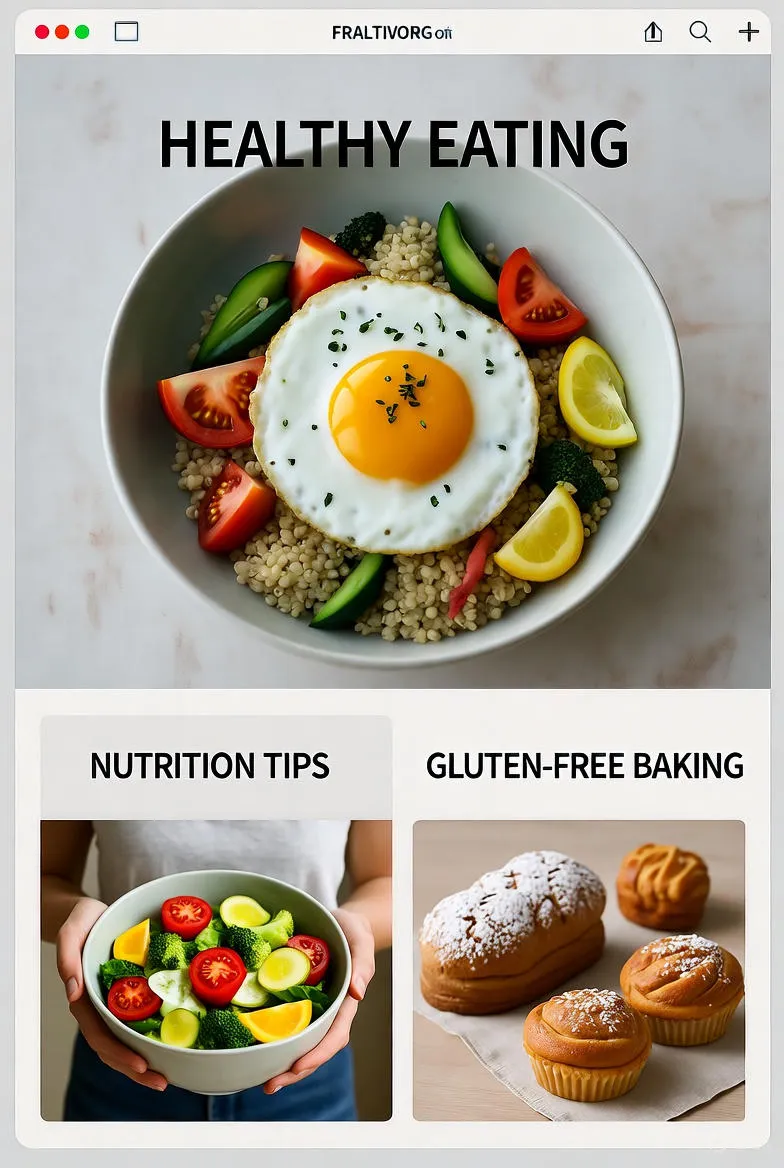Unlocking the Health Benefits of Gluten-Free Grains: A Comprehensive Guide
Discover the top health benefits of gluten-free grains like quinoa, millet, and buckwheat. Improve digestion, manage weight, and boost nutrition with this comprehensive guide to gluten-free living.

In today's health-conscious world, more people are exploring dietary shifts to improve their well-being, and gluten-free grains have emerged as a powerhouse option. These nutrient-dense alternatives offer a world of benefits without the gluten that can cause issues for many. Whether you're managing celiac disease, gluten sensitivity, or simply seeking to diversify your diet, incorporating gluten-free grains can transform your meals and your health.
What Are Gluten-Free Grains?
Gluten-free grains are those that naturally lack gluten, a protein found in wheat, barley, and rye. Unlike traditional grains that form the backbone of many staple foods, these alternatives include quinoa, rice, millet, buckwheat, amaranth, sorghum, teff, and oats (when certified gluten-free to avoid cross-contamination). Each brings unique textures, flavors, and nutritional profiles to the table, making them versatile for everything from breakfast porridges to hearty salads.
Quinoa, often called a superfood, is technically a seed but used as a grain. It's complete protein, containing all nine essential amino acids. Rice, a global staple, comes in white, brown, black, and red varieties, each offering varying levels of fiber and antioxidants. Millet provides a mild, nutty taste and is rich in magnesium, while buckwheat—despite its name—remains entirely gluten-free and packs a punch with rutin, an antioxidant flavonoid.
These grains have been cultivated for centuries across cultures. Amaranth, revered by ancient Aztecs, offers a buttery pop when cooked. Sorghum, a drought-resistant crop from Africa, is now a favorite in gluten-free baking. Teff, the tiny Ethiopian grain, forms the base for injera flatbread and is loaded with calcium and iron. Understanding these basics sets the stage for appreciating their profound health impacts.
Benefits for Digestive Health
One of the most celebrated advantages of gluten-free grains is their gentle effect on the digestive system. For individuals with celiac disease or non-celiac gluten sensitivity, avoiding gluten prevents inflammation, damage to the small intestine, and symptoms like bloating, diarrhea, and fatigue. But even for those without sensitivities, these grains promote better gut health through high fiber content.
Brown rice and oats, for instance, are excellent sources of soluble fiber, which feeds beneficial gut bacteria and helps regulate bowel movements. Studies have shown that regular consumption of fiber-rich grains can reduce the risk of irritable bowel syndrome (IBS) and diverticulitis. Quinoa's fiber aids in cholesterol absorption in the gut, lowering overall levels and supporting smoother digestion.
Millet stands out for its role in soothing the gut lining due to its alkaline nature, which can balance acidity levels. Buckwheat's resistant starch ferments in the colon, producing short-chain fatty acids that nourish intestinal cells. Incorporating a variety of these grains ensures a broad spectrum of prebiotic fibers, fostering a diverse microbiome essential for immunity and mental health.
- Reduced Inflammation: Gluten-free options minimize autoimmune responses in sensitive individuals.
- Improved Regularity: High insoluble fiber from sorghum prevents constipation.
- Gut Microbiome Support: Teff's complex carbs promote probiotic growth.
Transitioning to these grains isn't just about elimination; it's about proactive nourishment. Start with small swaps, like using quinoa in place of couscous, to ease your system into the benefits.
Nutritional Advantages of Gluten-Free Grains
Beyond digestion, gluten-free grains shine in their nutrient density. They often outpace gluten-containing counterparts in vitamins, minerals, and antioxidants. Quinoa leads with its protein content—about 8 grams per cooked cup—making it ideal for plant-based diets. It's also rich in iron, which combats anemia, and folate for cell repair.
Amaranth delivers a rare combo of lysine and methionine, amino acids typically low in grains, alongside squalene, a compound with cholesterol-lowering and anti-cancer properties. Millet boasts high levels of B-vitamins, crucial for energy metabolism, and phosphorus for bone health. Buckwheat provides manganese for antioxidant enzyme function and magnesium to ease migraines and muscle cramps.
Sorghum is a standout for polyphenols, plant compounds that fight oxidative stress, potentially reducing chronic disease risk. Teff, though small, packs more calcium than milk per serving, supporting osteoporosis prevention, and vitamin C for immune boosting. Brown rice offers manganese and selenium, antioxidants that protect against heart disease and cancer.
These grains collectively address common nutritional gaps. In a world where processed foods dominate, opting for whole gluten-free grains ensures you're getting unadulterated goodness. Pair them with veggies and proteins for balanced plates that fuel sustained energy.
Comparing Nutritional Profiles
| Grain | Protein (g/cup cooked) | Fiber (g/cup cooked) | Key Nutrients |
|---|---|---|---|
| Quinoa | 8 | 5 | Iron, Folate |
| Brown Rice | 5 | 3.5 | Manganese, Selenium |
| Millet | 6 | 2 | Magnesium, B-Vitamins |
| Buckwheat | 6 | 4.5 | Rutin, Manganese |
| Amaranth | 9 | 5 | Lysine, Calcium |
This table highlights why diversifying your grain intake is key—each offers something unique to round out your nutrition.
Weight Management and Metabolic Health
Gluten-free grains play a pivotal role in weight control, thanks to their low glycemic index (GI) and satiating properties. Foods with a low GI release sugar slowly, preventing blood sugar spikes and crashes that lead to cravings. Quinoa and buckwheat, with GIs around 50, stabilize energy levels, curbing overeating.
The fiber in these grains expands in the stomach, promoting fullness. A study in the Journal of Nutrition found that higher whole grain intake correlates with lower BMI. Millet's low calorie density—about 120 calories per cup—allows generous portions without excess energy intake.
For metabolic syndrome, these grains help. Sorghum's tannins inhibit fat absorption, aiding lipid profiles. Teff's resistant starch improves insulin sensitivity, beneficial for prediabetes. Incorporating them into meals like grain bowls or pilafs can replace calorie-heavy refined carbs, fostering sustainable weight loss.
- Portion Control: Use amaranth in puddings for dessert-like satisfaction.
- Meal Prep: Batch-cook rice for quick, balanced lunches.
- Hydration Pairing: Grains absorb water, enhancing hydration efforts.
Remember, consistency matters. Track how these swaps affect your hunger cues and adjust accordingly for optimal results.
Supporting Heart Health
Cardiovascular benefits abound with gluten-free grains. Their soluble fibers bind to bile acids, excreting cholesterol and lowering LDL levels. Oats, even gluten-free, contain beta-glucan, proven to reduce heart disease risk by 20% in meta-analyses.
Buckwheat's fagopyrins dilate blood vessels, improving circulation and blood pressure. Quinoa's plant sterols block cholesterol absorption, similar to statins but naturally. Millet's magnesium relaxes arteries, while sorghum's policosanols extend this effect.
Antioxidants in amaranth and teff combat inflammation, a root cause of atherosclerosis. Regular consumption aligns with dietary guidelines recommending 3 servings of whole grains daily for heart protection. Simple additions like millet porridge for breakfast can accumulate these gains over time.
Versatility in Cooking and Lifestyle Integration
The true magic of gluten-free grains lies in their adaptability. Quinoa flourishes in salads, mimicking tabbouleh's fluffiness. Rice stars in risottos or sushi, while millet subs for polenta in creamy dishes. Buckwheat groats make kasha, a Russian staple, or gluten-free pancakes.
Amaranth pops like tiny corn for snacks or thickens soups. Sorghum syrup sweetens baked goods, and teff batter yields spongy pancakes. Experiment with global recipes: Ethiopian teff stews or Indian millet khichdi. These grains store well, with long shelf lives, making them pantry essentials.
For busy lifestyles, they cook quickly—quinoa in 15 minutes—and freeze beautifully. Kids enjoy them in energy bars, and athletes appreciate the carb-protein balance for recovery. Sustainability-wise, many like sorghum require less water, appealing to eco-conscious eaters.
Recipe Ideas to Get Started
- Quinoa Stuffed Peppers: Mix with veggies and herbs for a vibrant main.
- Millet Breakfast Bowl: Top with fruits and nuts for a fiber boost.
- Buckwheat Soba Noodles: Toss in sesame-ginger sauce.
- Amaranth Porridge: Sweeten with maple and cinnamon.
- Sorghum Salad: Combine with feta and olives.
These ideas showcase endless possibilities, turning nutrition into delight.
Potential Considerations and Tips
While benefits are plentiful, balance is key. Some gluten-free grains like rice can accumulate arsenic if not sourced carefully—opt for varieties from low-arsenic regions. Introduce them gradually to avoid digestive adjustments. Consult a dietitian for personalized advice, especially with conditions.
Label reading is crucial; certified gluten-free ensures purity. Storage in airtight containers preserves freshness. Budget-wise, bulk buying at co-ops saves money. With these tips, embracing gluten-free grains becomes seamless.
Conclusion
Gluten-free grains aren't just a trend—they're a timeless path to vitality. From gut soothing to heart fortification, their benefits ripple through every aspect of health. By weaving them into your routine, you're not only nourishing your body but also embracing diverse, flavorful eating. Start small, savor the changes, and watch your well-being flourish.


